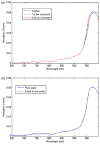Non-invasive tissue temperature measurements based on quantitative diffuse optical spectroscopy (DOS) of water
- PMID: 20551502
- PMCID: PMC3328132
- DOI: 10.1088/0031-9155/55/13/012
Non-invasive tissue temperature measurements based on quantitative diffuse optical spectroscopy (DOS) of water
Abstract
We describe the development of a non-invasive method for quantitative tissue temperature measurements using Broadband diffuse optical spectroscopy (DOS). Our approach is based on well-characterized opposing shifts in near-infrared (NIR) water absorption spectra that appear with temperature and macromolecular binding state. Unlike conventional reflectance methods, DOS is used to generate scattering-corrected tissue water absorption spectra. This allows us to separate the macromolecular bound water contribution from the thermally induced spectral shift using the temperature isosbestic point at 996 nm. The method was validated in intralipid tissue phantoms by correlating DOS with thermistor measurements (R=0.96) with a difference of 1.1+/-0.91 degrees C over a range of 28-48 degrees C. Once validated, thermal and hemodynamic (i.e. oxy- and deoxy-hemoglobin concentration) changes were measured simultaneously and continuously in human subjects (forearm) during mild cold stress. DOS-measured arm temperatures were consistent with previously reported invasive deep tissue temperature studies. These results suggest that DOS can be used for non-invasive, co-registered measurements of absolute temperature and hemoglobin parameters in thick tissues, a potentially important approach for optimizing thermal diagnostics and therapeutics.
Figures





Similar articles
-
In vivo water state measurements in breast cancer using broadband diffuse optical spectroscopy.Phys Med Biol. 2008 Dec 7;53(23):6713-27. doi: 10.1088/0031-9155/53/23/005. Epub 2008 Nov 7. Phys Med Biol. 2008. PMID: 18997265 Free PMC article.
-
Broadband diffuse optical spectroscopy measurement of hemoglobin concentration during hypovolemia in rabbits.Physiol Meas. 2006 Aug;27(8):757-67. doi: 10.1088/0967-3334/27/8/009. Epub 2006 Jun 13. Physiol Meas. 2006. PMID: 16772673
-
Determination of optical properties of turbid media spanning visible and near-infrared regimes via spatially modulated quantitative spectroscopy.J Biomed Opt. 2010 Jan-Feb;15(1):017012. doi: 10.1117/1.3299322. J Biomed Opt. 2010. PMID: 20210486 Free PMC article.
-
Quantitative In Vivo Imaging of Tissue Absorption, Scattering, and Hemoglobin Concentration in Rat Cortex Using Spatially Modulated Structured Light.In: Frostig RD, editor. In Vivo Optical Imaging of Brain Function. 2nd edition. Boca Raton (FL): CRC Press/Taylor & Francis; 2009. Chapter 12. In: Frostig RD, editor. In Vivo Optical Imaging of Brain Function. 2nd edition. Boca Raton (FL): CRC Press/Taylor & Francis; 2009. Chapter 12. PMID: 26844326 Free Books & Documents. Review.
-
Imaging in breast cancer: diffuse optics in breast cancer: detecting tumors in pre-menopausal women and monitoring neoadjuvant chemotherapy.Breast Cancer Res. 2005;7(6):279-85. doi: 10.1186/bcr1358. Epub 2005 Nov 28. Breast Cancer Res. 2005. PMID: 16457705 Free PMC article. Review.
Cited by
-
Quantitative diffuse optical spectroscopy for noninvasive measurements of the malaria pigment hemozoin.Biomed Opt Express. 2020 Sep 23;11(10):5800-5813. doi: 10.1364/BOE.401771. eCollection 2020 Oct 1. Biomed Opt Express. 2020. PMID: 33149987 Free PMC article.
-
Non-invasive monitoring of brain temperature by near-infrared spectroscopy.Temperature (Austin). 2014 Oct 30;2(1):31-2. doi: 10.4161/23328940.2014.967156. eCollection 2015 Jan-Mar. Temperature (Austin). 2014. PMID: 27226988 Free PMC article.
-
Optical signatures of thermal damage on ex-vivo brain, lung and heart tissues using time-domain diffuse optical spectroscopy.Biomed Opt Express. 2024 Mar 19;15(4):2481-2497. doi: 10.1364/BOE.517376. eCollection 2024 Apr 1. Biomed Opt Express. 2024. PMID: 38633088 Free PMC article.
-
Brain temperature monitoring in newborn infants: Current methodologies and prospects.Front Pediatr. 2022 Oct 4;10:1008539. doi: 10.3389/fped.2022.1008539. eCollection 2022. Front Pediatr. 2022. PMID: 36268041 Free PMC article. Review.
-
Investigation on the influence of the skin tone on hyperspectral imaging for free flap surgery.Sci Rep. 2024 Jun 17;14(1):13979. doi: 10.1038/s41598-024-64549-9. Sci Rep. 2024. PMID: 38886457 Free PMC article.
References
-
- Bayly JG, Kartha VB, Stevens WH. The absorption spectra of liquid phase H2O, Hdo and D2O from 0.7 μm to 10 μm. Infrared Phys. 1963;3:211–22.
-
- Belashev BZ, Ternovoi AN. Effect of optical temperature hysteresis. J Appl Spectrosc. 1996;63:573–6.
-
- Bevilacqua F, Berger AJ, Cerussi AE, Jakubowski D, Tromberg BJ. Broadband absorption spectroscopy in turbid media by combined frequency-domain and steady-state methods. Appl Opt. 2000;39:6498–507. - PubMed
-
- Buijs K, Choppin GR. Near-infrared studies of structure of water.1. Pure water. J Chem Phys. 1963;39:2035–41.
Publication types
MeSH terms
Substances
Grants and funding
LinkOut - more resources
Full Text Sources
Other Literature Sources
Miscellaneous
